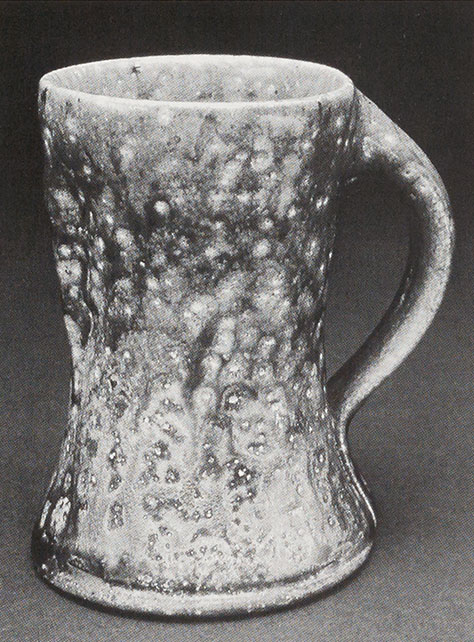The Impact of the Japanese Folk Craft Movement on 20th-Century American Ceramics
Twenty years ago, on the occasion of my twenty-first birthday, my brother James gave me a copy of The Unknown Craftsman by Soetsu Yanagi. I had already inhaled Leach's A Potter's Book and was enthralled by all I had read. I knew that I had found my calling.
Six months later I bicycled down to Cornwall to begin an apprenticeship with Michael Cardew, leaving Stoke-on-Trent and my industrial ceramic background behind me.
I felt like a youth going off to war, convinced that my cause was noble and just, and that my decision would help to make the world a better place. I had images of the Unknown Soldier running through my head. I was going to be an Unknown Craftsman, heroically doing battle with my culture.
Now, twenty years later, I have an opportunity to reflect upon the consequences of my decision, and to attempt to assess the impact of the Japanese folk craft movement on twentieth century American ceramics.
I think the direct impact has been minimal, contrary to the prevailing myth that the Leach/Cardew/Hamada/Yanagi school has a stranglehold on functional pottery in this country. There are, to be sure, a handful of noisy potters making pots within a very loosely-defined Mingei style, but the vast majority of functional potters today are influenced by a host of other styles, aesthetics and movements.
Applying a simple litmus test, I do not think there is anyone in America adhering strictly to all the underlying tenets of the folk craft movement. These tenets include: using locally available materials, making simple useful pots in large quantities by hand, working communally, and selling pots inexpensively. Yanagi suggested that under these conditions pots might be made that attained the highest possible aesthetic and spiritual values.
Stretching the rules a little, a case could be made for Native American potters in the Southwest, the horticultural ware producers in northern Georgia and elsewhere, and a few of the folk potters in the Southeast. By and large, however, potters in America don't adhere to these tenets, wittingly or unwittingly.
Examining each of these tenets will throw light on why the impact of Yanagi's vision and thinking has been so slight.
Firstly, rather than using locally available materials, American ceramics is dominated by materials provided by large companies that are mined far afield and distributed nationwide, if not worldwide. This has enabled potters to move beyond the constraints of geography and set up shop wherever they want, whether down-town, in the suburbs or in the desert. Instead of regional styles of pottery identifiable by the materials of those areas, now materials that are little more than brand names allow the same pots to be made anywhere.
There is an argument that since the world has become a global village that all the world's material are now local. That is like suggesting that the foodstuffs reconfigured from around the world at your nearest McDonald's are also local.
Instead of many local feldspars that a few potters in each particular location used, now there are just a few feldspars that everyone uses; one or two brands fit all. Instead of the delicious complexity of local clays, refined to greater or lesser degrees by the potters themselves, we buy airfloated, pre-mixed clay bodies from suppliers, blended from clays collected far afield, with names like "Rod's Bod'', "Brown Stoneware Clay" or
"Craggy Crunch".
Analogous to this might be a world in which no one produces wines in small independent wineries anymore. Their individual complexities and subtleties having been replaced by the bland monopoly of Gallo, there is nothing else to drink. Or, that there are no longer organic vegetables available, only flavorless, agribusiness produce. Changes in the wider world are reflected in our own. The giant hypnotizes the little guy. We might ask ourselves to what extent we have become a nation of MacPotters, our aesthetic sensibilities diminished by convenient, generic materials and equipment sold to us through relentless advertising. Our capacity for individual aesthetic expression has undoubtedly been magnified, but just how diverse can the quality of that expression be if we all use the same pure materials and standardized equipment?
The simple tools that produced folk pots have also been replaced by extremely sophisticated technologies. I have a kick wheel, but I also have an electric wheel whose power comes from a nearby nuclear power station. There are computer-controlled kilns, Giffin Grips, ram presses, sophisticated refractories - a panoply of labor-saving devices to ease our struggles. Needless to say, the quality of the work produced with these new refined, generic, sophisticated materials and equipment is very different from the quality admired by Yanagi.
(There is a current interest in woodfiring, but the emphasis in this trend is not on functional ceramics in the Mingei tradition. Anagama kilns produce rarefied objects that may be functional, but are more connected to the aesthetic of the tea ceremony, away from which Yanagi was venturing.)
Another tenet of the Mingei movement is that commerce diminishes or even destroys good craftwork. The communal village, with shared labor and kilns, is the hypothetical ideal. America, however, is a land of commerce, where most potters outside academia exist in the commercial world. Potteries are run as individual businesses within a cash economy and few, if any, operate cooperatively. Furthermore, the marketplace and industrialism have made mass-produced goods so inexpensive that in order to survive, handmade functional objects have become high-priced luxury goods, appealing to the taste of a different clientele than the folk tools produced for a working community in the Mingei tradition.
But in many indirect ways, the impact of Yanagi, Leach and Hamada has been strong and lasting. They were messengers, bringing a complex aesthetic appreciation for Asian ceramics and global folk craft to America, couched within the framework of a particular philosophy. If we were to hold up a score card measuring American functional potters' strict adherence to Mingei ideals the score, not surprisingly, would be very low. They were not the first to introduce these types of ceramics to America, but they were the ones who opened the door through which many Americans walked in order to begin their own explorations of Asian ceramics, folk art and Buddhist philosophy.
They did it at a time of profound social upheaval. I was not the only one to rebel against my culture and class and "go back to the Earth". As a member of a second generation of Mingei-influenced potters I am subject, like everyone else, to other influences. I would like to examine some of these to further explain why the impact of the Japanese Folk Craft Movement has been so weak in this country.
Movements and ideologies are about power and control, and do not exist in isolation. They exist concurrently with others and must compete with them. Such was the case in the 1950s and 60s when Yanagi, Leach and Hamada came to America. When they arrived here, the Bauhaus Movement, led by the Wildenhains and Natzlers, was already well-established, particularly on the West Coast. The Bauhaus, along with Alfred University and Daniel Rhodes' Clay and Glazes for the Potter have had, and in my opinion continue to have, a much more dominant influence on the "look" of functional ceramics in America than the Mingei movement, A Potter's Book or The Unknown Craftsman.
And then, of course, there was Rosanjin Otis, Abstract Expressionism, Funk, Fetish Finish, Kansas City, the Narrative School and all other fine art styles that continue to compete for our attention and influence the aesthetic decisions we make. Very few, relative to all other schools, have been directly influenced by the Mingei movement.
It is interesting to reflect for a moment on the influence of the Bauhaus and the Mingei movement on Peter Voulkos and the development of Abstract Expressionism. Originally trained by Bauhaus-influenced teachers, Voulkos was making the tightly-machined pots characteristic of that style until Hamada and Co. showed up at the Archie Bray Foundation. The looseness and eccentricity of Hamada's technique were inspirational to Voulkos. I would contend that the seed of his expressionism resides in folk pottery. His pieces are like magnified and exaggerated folk pots. If you look, for instance, at the back of a Moroccan earthenware bowl, the scratches, tears, finger marks, stone blow outs and wire twists are pure Voulkos. Voulkos' gift lies in his recognition that process and action contain form and beauty. (I can safely say that had I been trained under the influence of the Bauhaus then I too would have become an Abstract Expressionist.)
Another reason the impact of the Mingei movement has not been stronger is its idealistic anachronism. Ruskin, Morris and Yanagi were pre-Socialists reacting against industrial advances, but their reaction did not slow the pace of change. At its core, the Mingei movement is radically anti-industrial and anti-capitalist. It appeals to the independent-minded who seek a semblance of autonomy or isolation, a desire to go it alone and "get off the grid," and is mimicked, in rhetoric at least, at its extreme by the Unabomber. The demise of Mingei ideals parallels the demise of left wing idealism. The Left struggles for meaning in a world increasingly gripped by the velvet venality of corporate oligarchy.
Leach and Yanagi, furthermore, have been criticized
for assuming a puritanical, self-righteous, high moral tone that sticks in the craw of many. We don't like to be told to "Eat Your Vegetables," or to be told what is a good pot and how we should make it. We want to find out for ourselves. This is the land of individualism and self-expression, not tradition and communalism.
Making pots according to Yanagi's tenents is physically demanding and requires an elaborate and isolated social structure to exist. The modern world has invented a myriad of ways to make life less strenuous. Most people would rather have a washing machine, a refrigerator, a cellular phone, buy clay out of a bag ready-to-go and have an electric wheel and kiln rather than exhaust themselves with the alternatives. Folk potters themselves are likely to be the first to embrace new technologies. After spending a couple of days shoveling clay into a hammer mill or at the end of a four-day firing, I can well understand why people are disinclined to follow this route. The defiant "aesthetic of exhaustion" versus the compliant "aesthetics of convenience".

Folklorist Henry Classie suggests in his book The Spirit of Folk Art that "Folk art is a critical weapon; it is a corrective concept, balancing the personal with the social, the progressive with the traditional, the novel with the perfect, the material with the spiritual. Folk art is a reaction to simplification and error. Folk art calls goodness and reason, the smell of the earth, and the glory of God back into Art."
One of the paradoxes of the folk art movement is that the interest and patronage of the urban elite elevated folk art from its rural, communal, unpretentious roots into a position of higher rank. Handmade folk objects have assumed an honorific value that is higher than the corresponding machine-made product. The so-called "Peasant Bread" at our local gourmet grocery costs five dollars a loaf.
It is one of the conceits of the folk art movement that quality suffers when folk artists are paid more for the objects they produce. It is romantic and perverse to value the poverty of folk artists, as if in an attempt to escape the gilded constraints of the social order that entraps us at home. Poor folk artists wouId rather be rich folk artists. They live in the same commercial world as everyone else and have the same bills to pay and the same dreams to realize.
Yanagi was the son of a high-ranking military officer with connections to the Imperial household. It is interesting to speculate as to why someone from his high social class should be drawn to the work of craftspeople from the other end of the social spectrum. The pots usually associated with his high status, let's say Imperial porcelain or Sevres porcelain, tend to be delicate, sophisticated, elaborate, abstract, remote and untouchable, not unlike the Emperor of Japan.
Folk pots, on the other hand, tend to be useful, hard-working, robust, direct, warm, friendly and embraceable. I wonder if Yanagi's love of these pots came from a desire to have attributes around him that may have been absent in his own class upbringing, his own corrective balancing.
Much though I love the idea of an "unknown craftsman," I have never met one. As Louise Cort has pointed out, these supposedly unknown craftsmen, though unrecognized by the elite, were known in their own communities. Nor do I accept the notion of effortless, unselfconscious beauty. I've never met an unselfconscious craftsman. I've met modest ones, and ones so strung out that they were temporarily unaware of what they were doing, but none without a sense of themselves. Nor have I seen a pot that wasn't an effort to make, no matter how effortless its making might appear. All the folk potters I've met have finely attuned senses of beauty and are keenly aware of their skills and of the aesthetic decisions they make about shape, color, texture and decoration. They are no different in their possession of aesthetic sensibilities from fine artists. Following this argument, contrary to Yanagi's reading, I suggest that the Kizaemon O ldo tea bowl was made by a potter who knew what he was making and was aware of its beauty. Not that it was deliberately conceived, but that it was the normal outcome of a given set of skills and processes, over which the potter exerted some control and took some interest.
For alI this criticism of the Mingei movement, why is it that I still love folk pots? I may think the case against industrialism and progress is overstated, even a little paranoid, but I would still love to live in the harmonious world of its romantic vision.
Beyond the questionable "logic" of the folk craft movement are the actual objects themselves. They were made without the knowledge of folk art theory, and only in that sense are they innocent. The people who made them knew what they were making and made them with consummate skill and pride. (They also had a completely different relationship to their materials.) Yanagi's lasting contribution was to have recognized the great beauty inherent in folk objects and then proselytized about them outside the folk artists' communities. He dared to ask: "Where does beauty lie?" and then developed a forceful theory and an influential movement to bolster his answer. No small achievement, I suppose.
As a potter, it is more important for me to pay attention to the pots than it is to pay attention to the theories constructed around them. Theory can be useful, but practice makes better pots.
Having been imprinted with the knowledge of folk pottery at an impressionable age, my appreciation for them has only deepened, and I am happy to continue to make pots inspired by them. They conform to my most hopeful vision of the world. My response to folk pots is now more visceral and aesthetic than ideological. I love them above all others.
I love the complexity of their clays, the micro-aesthetic of stone bursts, twig blowouts, scratch marks, finger prints, the record of an organic clay treatment process. The pots made from these clays may be a Iittle unkempt, even scruffy, not smartly dressed up. Rather, like the lilies of the field, untarrying. Not dehydrated, sterile, inert and Iifeless, suffocated in a plastic bag.
I love the quality of their color, again a function of materials and process-rich, vibrant, inviting and radiantly healthy.
I love their shapes-fluent, strong, direct, purposeful, clear, honest, resonant, a delight to live with.
I love their decorations - charming, alive, sometimes fastidious, sometimes loose, considered but not static, playful but not perfunctory.
And then you get to hold them, handling their heft, fondling their intimate mysteries. Their usefulness allows you to pick them up regularly and put them in your face, bringing them to your lips, examining right in front of your eyes the color brown or the color pink, or green or blue, touching their textures lovingly, lifting their crazed veils and living with their utmost secrets.
Here is another quote from Henry Classie: "Art is the joy we find in work; it is the record of our bodies bumping through the world, our wits at war with the unknowable. It is the story of our fumbling towards collaboration, and our union with the power that moves the universe. Art is the best that can be done."


